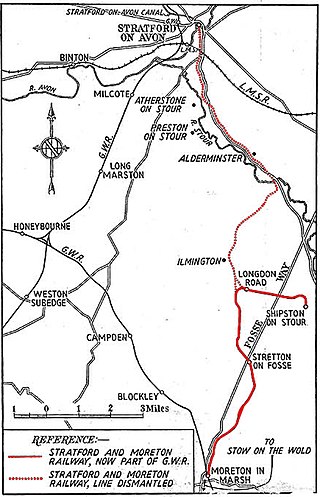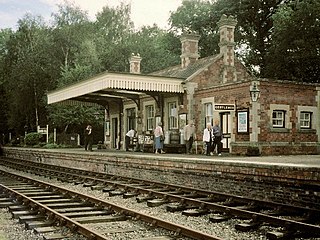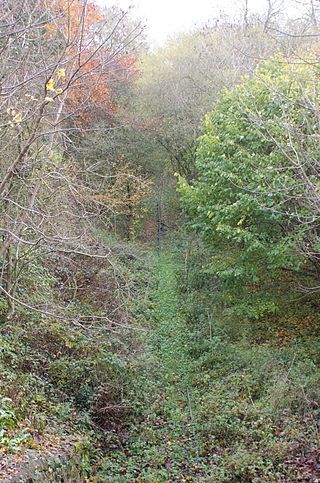
The Great Western Railway (GWR) was a British railway company that linked London with the southwest, west and West Midlands of England and most of Wales. It was founded in 1833, received its enabling act of Parliament on 31 August 1835 and ran its first trains in 1838 with the initial route completed between London and Bristol in 1841. It was engineered by Isambard Kingdom Brunel, who chose a broad gauge of 7 ft —later slightly widened to 7 ft 1⁄4 in —but, from 1854, a series of amalgamations saw it also operate 4 ft 8+1⁄2 in standard-gauge trains; the last broad-gauge services were operated in 1892.

The Gloucestershire Warwickshire Steam Railway is a volunteer-run heritage railway which runs along the Gloucestershire/Worcestershire border of the Cotswolds in England.

The Stratford and Moreton Tramway was a 16-mile (25-km) long horse-drawn wagonway which ran from the canal basin at Stratford-upon-Avon in Warwickshire to Moreton-in-Marsh in Gloucestershire, with a branch to Shipston-on-Stour. The main line opened in 1826, whilst the branch to Shipston opened in 1836.

The Cotswold Line is an 86+1⁄2-mile (139.2 km) railway line between Oxford and Hereford in England.

Leominster railway station lies on the Welsh Marches Line, serving the town of Leominster in Herefordshire, England. It is situated 11+1⁄4 miles (18.1 km) north of Hereford. The station has two operational platforms, for northbound services via Ludlow and southbound via Hereford; in the past, it had three more for discontinued services to Worcester and Kington.
The Oxford, Worcester and Wolverhampton Railway (OW&WR) was a railway company in England. It built a line from Wolvercot Junction near Oxford to Worcester, Stourbridge, Dudley and Wolverhampton, as well as some branches.
Hereford has seen a history of expansion and decline in its railway history.
The Merthyr, Tredegar and Abergavenny Railway, also known as the Heads of the Valleys line, was a railway line which operated between 1860 and 1958 between the Monmouthshire town of Abergavenny and the Glamorgan town of Merthyr Tydfil in South East Wales.
The Shrewsbury and Hereford Railway was an English railway company that built a standard gauge line between those places. It opened its main line in 1853.
The Hereford, Hay and Brecon Railway (HH&BR) was a railway company that built a line between Hereford in England and a junction with the Mid-Wales Railway at Three Cocks Junction. It opened its line in stages from 1862 to 1864. It never had enough money to operate properly, but the Midland Railway saw it as a means of reaching Swansea, and from 1869 the Midland Railway was given exclusive running powers over the HH&BR. There was then a long-running dispute over whether the Midland inherited rights of access previously granted to the HH&BR.

The Midland and South Western Junction Railway (M&SWJR) was an independent railway built to form a north–south link between the Midland Railway and the London and South Western Railway in England, allowing the Midland and other companies' trains to reach the port of Southampton. The M&SWJR was formed in 1884 from the amalgamation of the Swindon, Marlborough and Andover Railway and the Swindon and Cheltenham Extension Railway. The line was absorbed by the Great Western Railway at the 1923 grouping of the railways, and became part of British Railways on nationalisation in 1948. The railway closed to passengers in 1961, and to goods between 1964 and 1970. A small part of it has been reopened as the heritage Swindon and Cricklade Railway.

The Coleford, Monmouth, Usk & Pontypool Railway (CMU&PR) was a standard gauge railway of 16 miles (26 km) which ran from Monmouth to Little Mill, near Pontypool in Monmouthshire, Wales. It was intended to convey the mineral products of the Forest of Dean to the ironworks of South Wales, by connecting to the Newport, Abergavenny and Hereford Railway at Little Mill Junction. The NAHR made the onward connection over its Taff Vale Extension line. The CMU&PR intended to acquire the Monmouth Railway, actually a horse-operated plateway, and convert it to locomotive operation.
The Worcester and Hereford Railway started the construction of a standard gauge railway between the two cities in 1858. It had needed the financial assistance of larger concerns, chiefly the Oxford, Worcester and Wolverhampton Railway, and the Newport, Abergavenny and Hereford Railway. It opened its line progressively from 1859 to 1861, delayed by exceptionally difficult tunnelling at Colwall and Ledbury. The company was purchased by the West Midland Railway in 1860, and that company amalgamated with the Great Western Railway in 1863.
Leominster and Kington Railway was one of four branches which served the Welsh Marches border town of Kington, Herefordshire.
The Shipston-on-Stour branch was a 9-mile (14 km)-long single-track branch railway line that ran between a junction near Moreton-in-Marsh, on the present day Cotswold Line, to Shipston-on-Stour, via two intermediate stations, Longdon Road, and Stretton-on-Fosse.

Rowden Mill railway station was a railway station located on the Worcester, Bromyard and Leominster Railway in England.

Fencote railway station was a railway station on the Worcester, Bromyard and Leominster Railway in Hatfield and Newhampton, Herefordshire, England.

The Bromyard and Linton Light Railway is a 1-mile (1.6 km) single track, 2 ft narrow gauge railway line that runs between Bromyard and the Linton Industrial Estate, just off the A44. The track is laid on the bed of the old BR Worcester, Bromyard and Leominster Railway line. The track runs from an old depot, close to the site of the old Bromyard station, and ends under a bridge near a hospital turned flat block. The bridge was constructed in 1877 and carries a lane. There are disused engines in sheds at the main depot and Linton depot. The present track was used for the disused sandstone quarry.

Hatfield and Newhampton is a civil parish in the county of Herefordshire, England, and is 11 miles (18 km) north from the city and county town of Hereford. The closest large town is Leominster 4 miles (6 km) to the west. The parish includes the small village of Hatfield, the former extra-parochial liberty of New Hampton, the site of former abbey lands of Fencote, the preserved Fencote railway station, and the Grade II* listed 11th-century Church of St Leonard.













